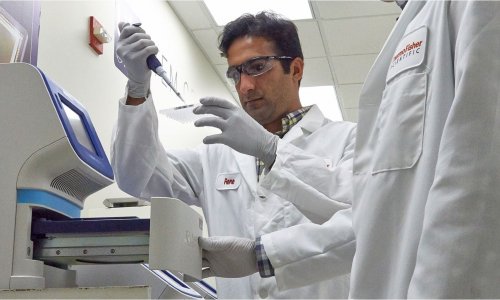Osmometry
The clinical use of controls, materials and osmometry
Osmolality is a simple, rapid and relatively inexpensive procedure that is important in the diagnosis of many physiological conditions, because the measurement of osmolality often provides information that cannot be obtained by any other method.

Background
Freezing point osmometry measures the total solute concentration in a liquid. It is most convenient to describe freezing point as the concentration of particles in solution. Freezing point won’t tell you how big these particles are, or what shape they have, or if they are charged. It will tell you how many you have. At low concentrations, freezing point is linear with the number of dissolved particles.
Clinical Relevance
It is generally accepted that osmotic effects have a major place in the maintenance of equilibrium in the living body with respect to various functions and to the chemical composition of the fluids and tissues, examples: temperature, heart rate, blood pressure, water content or blood sugar. These effects occur within or between cells and tissues where they cannot be measured. One troublesome problem in clinical medicine is the maintenance of adequate body fluids and proper balance between extracellular and intracellular fluid volumes in seriously ill patients. Fluid and electrolyte abnormalities are not disease, but the manifestations of disease. Physiological mechanisms, which control water intake and output, appear to respond primarily to serum osmolality. Renal regulation of output is influenced by variations in rate of release of pituitary antidiuretic hormone (ADH) and other factors in response to changes in serum osmolality. These changes also serve as a stimulus to moderate thirst and are sensitive in order to limit variations in osmolality in normal patients to about 1%.
An increase in plasma osmolality of 1% will stimulate ADH release, which results in the reduction of urine flow and stimulates thirst, causing water intake to occur. This transfer of water through cell membranes occurs so rapidly that any lack of osmotic equilibrium between the two fluid compartments in any given tissue usually is corrected quickly. The rapid transfer of water does not mean that complete equilibration occurs between the extracellular and intracellular compartments throughout the entire body within this same short period of time. Fluid usually enters the body through the gut and then must be transported by the circulatory system to all tissues before complete equilibration can occur. In the normal person, after drinking water it may require
30–60 minutes to achieve reasonably good equilibrium throughout the body. Osmolality determines the physiologic acceptability of a variety of solutions used for therapeutic and nutritional purposes.
Using osmolality
Osmolality can be used for routine analysis and on patient samples requiring stat measurements. If screening for toxin ingestion is done, stat osmolality should be included as a rapid screen for low molecular weight toxins. Treatment of neurosurgical patients often requires calculation of osmotic gap to monitor mannitol therapy, to assure adequate dosage and to prevent toxicity. Evaluation of patients with alteration in serum sodium or abnormal urine output is facilitated by the measurement of osmolality. Because freezing point osmolality delivers a more accurate measurement of urine solute concentration, this is preferred over methods based on ionic strength or specific gravity. When stat results are required, results are available within a short time of specimen collection, which serves to minimise errors caused by loss of volatile substances or production of osmotically active compounds through in vitro metabolism.
Control solutions and materials
Control solutions and materials can be defined as a solution or patient specimen used solely for quality control purposes. Control products are widely available commercially in liquid, lyophilised form, packaged in small amounts suitable for daily use. They can be bought from the same companies that sell reagents and instrumentation. It is common for laboratories to purchase complete testing packages, which serve to enhance their quality control programme.
By purchasing from a sole source, differences in products and effects on method or instrument performance can be minimised. Good control materials should have the same matrix as the specimens being tested, so that they behave the same as the patient specimen. By developing materials to minimise alterations, a manufacturer can help to eliminate interferences in the testing process.
Liquid controls and materials such as Protinol – serum control, Renol – urine control, Clinitrol 290 – reference solution, and Osmolality Linearity Set, are designed to perform optimally. These are good value, as they reduce waste due to stability, eliminate vial to vial variability, and reduce operator errors that are frequently associated with the reconstitution process, all whilst enhancing laboratory quality and confidence in testing.
Basic quality control practices
CLIA ’88 – Clinical Laboratory Improvement Amendments of 1988 are requirements for general quality control (QC) provisions and personnel qualifications for moderate complexity testing.
JCAHO – JCAHO follows CLIA ’88 and mandates for moderately complex methods that external controls (usually liquid) be run to verify manufacturer’s claims and to validate that no change occurred with the testing system. Labs must be certain that these results meet its acceptance criteria before patient results are reported.
CAP – Controls must be included with all tests, even those identified in CLIA ’88 as waived. Cap requires an audit trail that ties patient results to both a positive and negative control each day of use.
Advanced Instruments ControLine products
These reliable, quality products help clinical labs to achieve the most accurate results with the only comprehensive set of control solutions and materials designed specifically for osmometers.
They can help laboratories avoid expensive workflow disruptions and ensure the reliability of patients’ results. With a tighter tolerance than multi-analyte controls, it is easier for users to identify when action needs to be taken due to results found outside satisfactory control limits.
Protinol – Protein-based Serum Controls is designed specifically for clinical laboratories testing blood samples and formulated to produce the most consistent, reliable results in the human serum range. Formulated at three levels, to allow users to comply with CLIA ’88 quality control requirements, the product is premixed and ready to use in three, 3 mL vials per kit (see box).
Renol – Urine Controls. Renol is the world’s only osmometer specific control solution for laboratories that test urine samples. The aqueous-based control material is manufactured to extremely tight tolerances for better repeatability and the most precise control over patient results. It comes premixed and ready to use in four, 3 mL vials of each value per kit. Formulation values include 300 and 800 mOsm/kg H2O. These concentrations are close to medical decision levels where performance is critical for the use and interpretation of the test.
To comply with CLIA 493.1218, labs should perform and document control procedures using at least two levels of control materials daily.
By utilising products designed specifically for osmometers and strengthening quality programmes, users will be able to track control results; identify shifts, trends, and random errors; apply control rules; and implement corrective actions.
Clinitrol – 290 Reference Solution and Calibration standards. These premixed and ready to use reference solutions and calibration standards meet CLIA 493.1217 regulations.
Labs will use Clinitrol 290 to monitor operator technique – particularly important with several shifts. Additionally, when following a calibration routine, Clinitrol 290 is a valuable tool for calibration verification. The calibration standards are manufactured to stringent NIST and ISO9000 quality systems standards, are stable, reliable, and accurate.
Osmolality Linearity Set. This product was designed to help clinical laboratories easily monitor instrument performance, which fulfils the CLIA 493.1213 requirement for establishment and verification of method performance specifications and reportable range of a laboratory method.
01.05.2007











